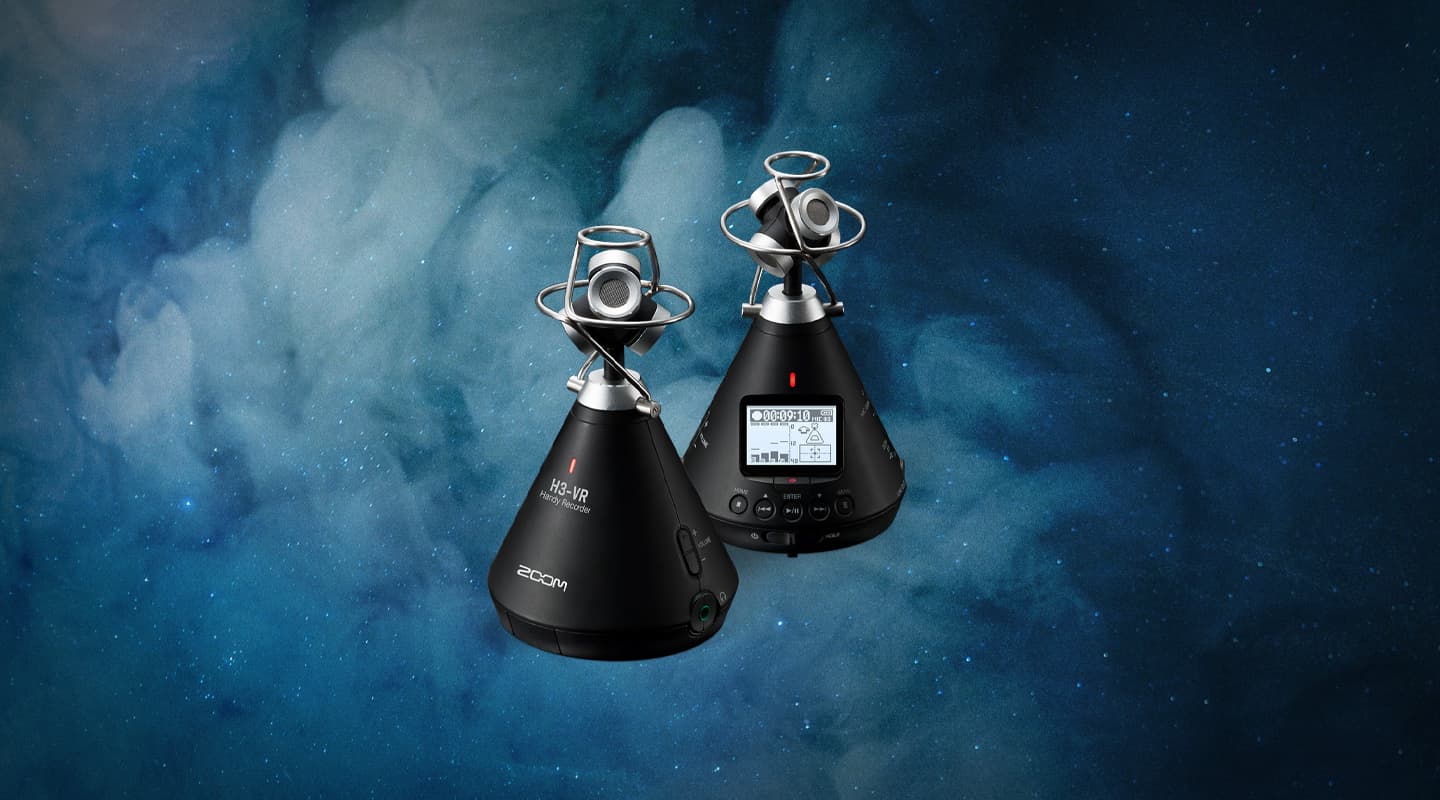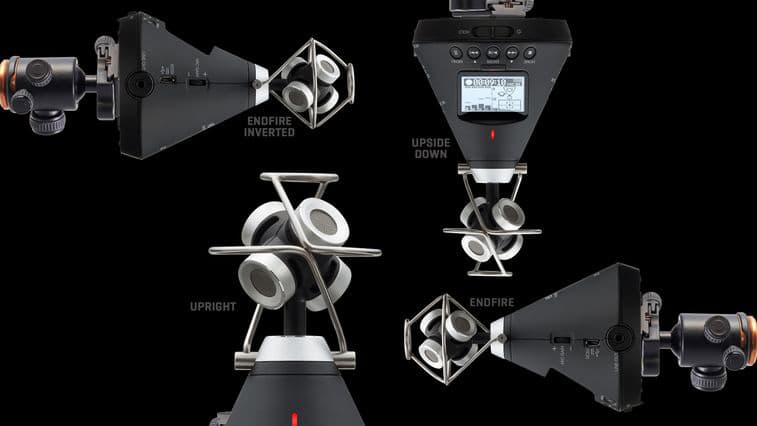
Review: Zoom H3-VR
An Ambisonics mic system and recorder for easy-to-wrangle 360° audio.
I have a lot of respect for Zoom and their products. I started creating SFX libraries many years ago when I lived in Japan and the original Zoom H4 was a critical tool for me. It was one of the first handheld recorders on the market and it allowed me to capture sounds that just would not have been possible with other devices. While Zoom’s devices may not be considered equivalent to the most expensive options on the market they excel at innovation and have done so at a rate that far exceeds their competitors.
I’m always happy to review Zoom products. I already own a wide range of its devices and each one has been purchased with a specific use in mind. Simply put, Zoom has often been the best tool for the task.
The H3-VR has several advantages right out of the box and I am confident in recommending it to certain users without even switching it on. With any piece of equipment, what really matters is what your use case is and how demanding your workflow is.
OUT OF THE BOX
My reason for recommending this device ‘sight unseen’ is simple: it is going to provide options for users that are practically impossible to find anywhere else.
Firstly, and most importantly the H3 records in Ambisonic A format and then automatically converts it on the device to Ambisonics B format. This alone makes it incredibly useful to a huge range of users.
Ambisonics is an interesting format to work with but it is also crazy-complex. I wrote the first book on VR/AR audio production a few years ago and I still have challenges remembering the various aspects and conversion processes, and why you might want this format versus that format.
The reality is most people just want a format that is simple and allows them to add cool-sounding audio to their 360 video or VR experience. For all those people, this device is perfect. Ease of workflow is far more important for many people than higher sample rate and bit rate or flawless mic preamps.
PRICE CHECK
The second aspect is the price. I did a quick online search for the H3 and here in Australia I found one for under A$500. This is a price point far lower than other ambisonic microphone systems.
Combine affordability with usability and many will find this an attractive offering. For people producing YouTube-style 360 content for social media consumption or for folk who just want to have some fun working in the spatial format, the H3 is everything they need to get started. Plus, as a single small device that has both the microphones and the recorder in a single form factor it is super convenient to integrate into a 360 camera setup. In an era where there is such a huge range of digital devices that offer complex ranges of options and workflows, a simple, clean and inexpensive option is going to win the argument a lot of the time.
NEED TO KNOW
Zoom H3-VR
360° Audio Recorder
THE DEVICE
I have noticed that Zoom products seem to fall into two categories. I will use the terms ‘Lightweight’ and ‘Sturdy’. I own two Zoom F6 recorders, I find them excellent devices and one of the reasons for that is they are of a solid build that allows me to use them in the field knowing they can deal with the punishment I might dish out. I would class the Zoom H4n in the same Sturdy category.
The H3 is more like the original H4 or the H1 recorder and these I put into the Lightweight category. In general, they are fine for careful use and can be used out in the field, but you need to be careful with how you transport and store them because they are not quite as robust as their Sturdy teammates. This may not be an issue for many, as an average user is not likely to be trekking through a swamp or climbing trees while trying to record, but it is a key aspect of the H3’s design and was one of the first things I noted to myself, “I need to be careful with this device when using it out in the field.”
The H3’s controls are nice and simple. The beauty of Ambisonics is that you have four channels and they need to be synced to capture the ambisonics space effectively. This means the device has a single gain dial that adjusts all four channels at once. It has clear and easy-to-access power and control buttons and, again, once you work out the format you are comfortable with you will rarely need to change it. Your initial setup of date and time and the format you want to work with is probably all you will need most of the time.
Other than that, press Record when you want to capture and Stop when you are done.
Again, while this all sounds very obvious, it is important to acknowledge that this simplicity is excellent for workflow and avoids mistakes and missed opportunities. The number of times I have had issues or made mistakes with my setup on my more complex devices are all just reminders of the awesome sounds I’ve missed out on because in the heat of the chase, I didn’t press one of the buttons when I should have. Keeping it simple may be the greatest feature of the H3.

ON DISPLAY
Zoom devices have always had very good displays of information compared with other devices of their generations, and the H3 is no exception. The display is super clear and easy to read and navigate. My close-range eyesight is fairly poor and I often have to switch glasses to read small text, but the clear backlit display on the H3 allows me to see everything with my normal glasses, which is excellent for speed and ease of use.
The ambisonics format uses a series of microphones to capture a sphere of audio. In a similar way to how a stereo mic setup captures everything to the left and to the right, the four capsules of the H3 are aligned to capture the whole sphere around them. This can result in amazing recordings of natural environments or music events or just the ambience of downtown. The H3 has a built-in six-axis motion sensor that detects when the device is not perfectly upright and adjusts its alignment accordingly, so that it records ‘up’ and orients what you capture, otherwise you could end up with recordings that sound very strange — upside down, for example. That said, it also has override options to this automatic system so you can lock its alignment to one of four options. For most people, the auto system will likely be enough, but it’s useful to have the overrides for when you want to get creative.
FORMATS
The H3 provides options for various recording formats. It defaults to Ambix and for anyone just wanting to capture a nice spatial audio recording it is best to leave it on that default setting. FuMa is an older ambisonic format and should only be selected if you specifically need it, and Ambisonic A outputs the direct data from the microphones with no decoding. You might use this if you were going to take the recordings and decode them with a software plugin. That approach may give you more specific control, but you would really need to know what you are doing. Particulars aside, it is very good to see that the H3 provide the options for all these formats as well as Stereo and Binaural.
Frankly, for a device that is under A$500 I am astounded at how clean it sounds


ROUND SOUNDS
Firstly, I would recommend as soon as you unbox the H3, that you put the little windshield on and leave it there. These microphones are very susceptible to wind noise, even just moving the device through the air in my hand triggers wind issues. The good news is the windshield takes care of it but it is worth being aware of.
Earlier, I spoke about preamps and how Zoom may not be up to the same standard as the top-end location sound gear. Well, I may need to retract that statement. The first test I do with any device is to go into a silent room and record something very quiet, so I grabbed a salt grinder and just moved it around the microphones as I operated it. This is a quiet sound and I had the input levels set reasonably high and the recording is super clean and sharp with almost no self-noise. Frankly, for a device that is under A$500 I am astounded at how clean it is. The H3 shows Zoom has really improved the preamps in their smaller devices.
The H3 is susceptible to handling noise, I would not recommend trying to use it while holding it, as the body of the device, and even the headphone cable plugged in, easily transmit vibrations to the mics. The very nature of ambisonic recordings is that you need to set up the device and leave well alone. The ambisonic sphere is like a photograph, a snapshot of what the device hears in a specific location, you generally don’t move them around that much. But if you were capturing 360 videos on the move you would need the optional fluffy wind protector and probably some kind of shockmount to remove vibration noise. The H3 can be mounted directly to the top of a tripod, or with the included adaptor you could mount it onto many models of camera. This is always going to be the best way to use the H3.
DEEP, CRISP & EVEN
The recordings I made were crisp and clean. The H3 mic capsules have a nice bright sound that assists with clarity, but, equally, when I spoke into the H3 it also captured a good sense of low-end weight to my voice — all up, a good response across the frequency range.
The specifications state it can handle up to 120dB which is plenty loud enough, and only specialist microphones usually go much beyond that limit.
The process of getting the recordings off the device took less than a minute to set up.
One final gripe: Zoom has a smartphone app that gives you remote control of the device if you have the wireless Bluetooth add-on. This is a really great idea if you want to capture nature sounds and not handle the device. But, it is iOS only. I’m disappointed Zoom hasn’t come to the Android party. It’s had a few years to do the development now. Most of my frustration lies in the fact I’m an Android user and I want the app!
ZOOMIES
I’ve used and reviewed most of Zoom’s previous offerings and they almost always represent great value. The H3-VR is no different. Personally, I’ll continue to use an Ambisonics mic with my Zoom F6 recorder as my setup. But I’m not exactly the target market. For the target market — people producing more straightforward 360 videos that want an easy and reliable way of capturing spatial audio — this is one of the best options available and the low price point only sweetens that deal.
























Seductive, I bought one, but way too much self-noise for nature recording.
Hi Dan
I find this super surprising, I always do a test in a quiet space to check mic and preamp noise and the H3 that I tested was one of the quietest devices I have tested in games. Like as quiet as devices many times its cost. So comparing your experience to mine might suggest there is an inconsistency between units as mine was great.
I suggest you contact your supplier as you might have a fault in your unit
cheers
Stephan
G’day Stephan, Thanks for the review.
This is a very tempting product to add to my arsenal for storm chasing as I have recently started recording 360 degree video of storms. My only concerns are wind noise and whether the unit is able to capture the full range of sound, from low thunder rumbles to high pitch “cracks”. Would I be wasting my time with this?